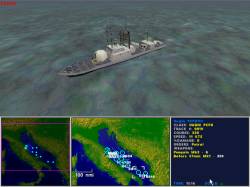Page 1
The Warship Database Project V6.5
By Steve MacGregorWhen is a game a simulation? We often use the word simulation when we really mean game - I know I do. When asked what I do in the evenings, I loftily say that I do research on computer simulations. At my advanced age it sounds so much more respectable than saying that I play computer games. However, while most people would agree that there is a difference between a game and a simulation, it can be very difficult to define this objectively. Was the original Panzer General a game? Are the Close Combat series simulations? For me, the main difference is that a game focuses on action and entertainment, while in a simulation I expect to be able to use real-world tactics and strategy to achieve real-world results, even when this entails extended periods when not much happens.
Fig. 1. The new Swedish Hugin Class PCFGWithin the strategy genre, I expect a simulation to include units having capabilities that reflect their actual capabilities, and an AI that initiates appropriate tactical responses. So when you think about it, the job of the strategy simulation designer is pretty simple, right? All you have to do is to model the performance of every item in the game accurately to the third decimal place and you will have a world beating simulation. Ah, if only life were so simple. In the real world no computer simulation can ever be 100% accurate, and most software is a balancing act between accuracy and playability. The appeal of a game often depends on how well the designers have managed this balancing act with respect to their target audience.
And so, finally, to Jane's Fleet Command. In many ways a fine piece of software, but in my opinion more a game than a simulation. In particular, sensor and weapon data have been simplified to the detriment of realism and the AI seems content to re-act rather than initiate action aggressively. Now, I am not one of those people who believe that accuracy in my games is an acceptable substitute for enjoyment. I find that some of the simplification of data in FC restricts the playability of the game. While it isn't fair to make direct comparisons, one of the joys of Harpoon (both in board game and computer iterations) was that the diversity of accurately modelled platforms, weapons and sensors made it possible to use real-world naval doctrine and tactics.
Restricting the data to generic simplifications in Fleet Command reduces the ability to do this. To give an example, air search (AS) radar in Fleet Command comes in three types: short range (25nm), medium range (75nm) or long range (100nm). All AS radars in the game are assigned one of these values, regardless of their actual capacity. Thus a very effective radar such as the SPS-49 fitted to the American Ticonderoga Class CG with its range of 300 nautical miles is simply treated as "Long Range", giving it no advantage in the game over lesser radar sets which are also classed as "Long Range". This broad brush simplification robs the game of much of the tactical nuance which comes from knowing the strengths of your units, and exploiting the relative weakness of the enemy.


